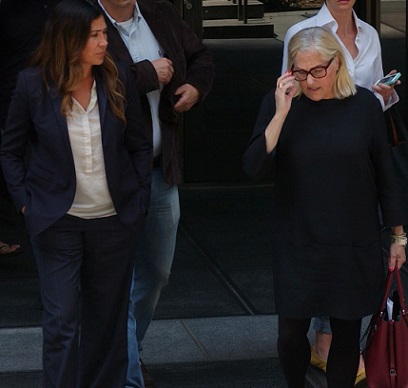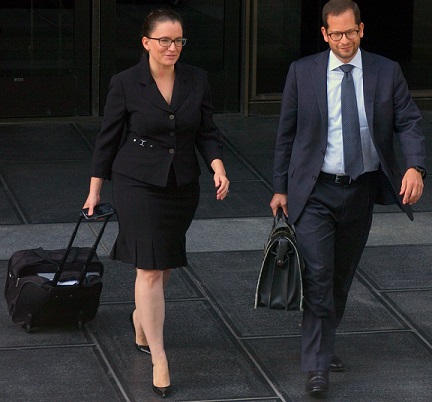47 More Counts Collectively Dismissed From Indictments In Criminal Organization Munir Uwaydah Case In Downtown Los Angeles. Prosecution Takes Another Huge Blow As Defense Wins Predominantly In Lack-Of-Foundation-Of-Evidence Arguments.
By Lonce LaMon - November 2, 2016
“It’s a shame that the prosecution was unable to get their act together…” the Honorable Kathleen Kennedy spoke out as she began her ruling in the late morning of Tuesday, November 1st 2016, in the Criminal Organization Munir Uwaydah case. The prosecution took yet another huge hit yesterday in the case of the notorious workers’ compensation fraud perpetrated by the organized crime ring of Dr. Munir Uwaydah to the tune of mega-millions of dollars. 47 more counts were dismissed in Department 109 of Clara Shortridge Foltz Criminal Justice Center in downtown Los Angeles after the defense submitted written motions, the prosecution answered, and more replies came and then were argued openly in court yesterday on 47 counts of capping and money laundering.
Attorney Jeffrey Isaacs, representing defendant Tony Folgar, an alleged capper who is still in custody, opened up the arguments by stating that California Statute 3215 prohibits the referral of patients covered by workers’ compensation insurance in exchange for fees. He argued that no admissible evidence was presented showing the services were covered by workers’ compensation and that the grand jury was not instructed that Statute 3215 was specifically only about workers’ compensation.
Isaacs stated the prosecution only offered one witness: Special Investigating Auditor Jane Ngo. He said the checks Jane Ngo referred to were not authenticated checks, plus the signatures were not authenticated. He indicated the checks were supposedly from Citibank but that the record was not clear. He called it a “true mystery, the origin of these records”.
According to Jeffrey Isaacs, “… all you have is the prosecution reading from faces of checks and then asking Ms. Ngo to verify.” But there’s no verification. There is “no attempt to lay a business records foundation.” And like with the prior Tax Counts, which were dismissed at the end of June, all the evidence was argued by the defense to be inadmissible.
.jpg)
Defendant Kelly Soo Park, right, is shown in this photo leaving court on August 4th 2016 with her husband, a retired City of Oxnard police officer, Tom Chronister. Kelly Soo sat in the front row of the court audience seats on Tuesday, November 1st 2016, next to her former domestic partner, defendant Ronnie Wayne Case. All the capping charges against her, Ronnie Case, and all the defendants were dismissed on November 1st due to lack of foundation of evidence. photo copyright Lonce LaMon, all rights reserved.
There was no custodian of records who authenticated the checks and bank records, Isaacs emphasized. The prosecution even stated during the grand jury proceedings that the signature on one of the checks was not recognizable.
Defense Attorney Jeffrey Isaacs: This puts a stake in the heart of the People’s argument.
The prosecution argued that the checks were not statements requiring a fit into the hearsay exception as they were not offered for the truth of the matter asserted. They were merely proof that checks were written, money was paid.
The judge asked to assume she accepted the argument, but where was the evidence that the checks were for patient referrals?
Catherine Chon, deputy district attorney, stated there was general evidence. But the judge insisted on hearing how the totality of evidence pointed to specific checks and specific patients. Chon referred to Yolanda Groscost.
Catherine Chon: When her home was searched (evidence was found). She (Yolanda Groscost) has always been a marketer. Marketer is a code word for capper. It’s circumstantial evidence. They found large amounts of cash. Patient lists.
Judge Kathleen Kennedy: How come those weren’t filed as counts? Because the statute of limitations had run?
Catherine Chon: Yes.
Judge Kathleen Kennedy: And you’re also saying a mere signature on a check (means it’s payment for patients)?
Catherine Chon: It’s circumstantial evidence. That relationship never changed. I bring in patients, he gives me money.
Jeffrey Isaacs reiterated the point that nothing connects the checks to payments in exchange for the referrals of workers’ compensation patients.
Jeffrey Isaacs: The short answer is that nothing connects the alleged referrals of patients (to the checks written). I don’t know who the patients are.
Before the grand jury, Special Investigation Auditor Jane Ngo was asked:
Question: What indicated that these checks relate to unlawful client referrals and not to something else?
SIA Jane Ngo: I can’t answer that.

Tatiana Torres Arnold, left, shown here exiting the front of the courthouse on July 1st 2016 with her attorney, Ellen Garafalo, had 17 counts of money laundering plus 27 counts of capping (unlawful patient referral) dismissed against her on November 1st 2016, due to lack of foundation of evidence. photo by Lonce LaMon, all rights reserved
Yolanda Groscost’s attorney, Joel Athey, presented with variations on the same arguments. Attorney Ellen Garafalo spoke representing Tatiana Torres Arnold. Tatiana’s counts of 11—27 were for money laundering. The prosecution conceded to Tatiana Torres Arnold’s demurrer attacking those counts without a single responsive argument. The prosecution simply submitted.
The line of reference was to the Tax Evasion Counts which were dismissed on June 29th 2016 because the prosecution failed to lay the foundation for the evidence before the grand jury. The judge spoke these immortal words which the defense has held close to the breast ever since: “The evidence code is not advisory. It is mandatory. It applies.”
Judge Kathleen Kennedy: (Counts) 11 – 27. Are you saying the demurrer is well taken?
The prosecution simply assented.
Jeffrey Isaacs had another chance to speak. He reiterated and reemphasized the authentication problem—that evidence is not admissible unless it is authenticated.
Jeffrey Isaacs: Here we do not even have the original checks. We have something that purports to be a copy.
Joel Athey, defense counsel for Yolanda Groscost, an alleged capper, then spoke again. He pointed out that Yolanda Groscost and Munir Uwaydah sued each other in 2008 and 2009. Again, ad nauseum, it is displayed that Uwaydah has a pronounced pattern and practice of attacking, rejecting, and then suing former partners, colleagues, and companions.
Then Nicole Van Dyk, representing still incarcerated Paul Turley, who was the highest executive of Frontline and Firstline next to Munir Uwaydah, spoke for all the defendants in the largest indictment of eleven defendants, which includes Kelly Soo Park. Then all the lawyers rested their arguments and allowed the judge to make her ruling.

Nicole Van Dyk, left, spoke to the court on behalf of all the defendants in the larger indictment of the two indictments on November 1st 2016. She is shown here leaving the courthouse on October 7th 2016 with her constant court partner, Benjamin Gluck. She and Gluck are from the law firm Bird Marella (the Bird firm) of Century City. The three capping counts were dismissed for all the defendants in the same indictment with their client, Paul Turley. photo by Lonce LaMon, all rights reserved
Judge Kathleen Kennedy: It’s a shame that the prosecution was unable to get their act together, so-to-speak, in --- short of the statute of limitations, in presenting the counts for which apparently they did have plenty of evidence which resulted from the execution of search warrants, obtaining of confessions, obtained from bank records pursuant to search warrants.
But for reasons that are unclear to me, they waited until the statute of limitations had expired as to those counts and then attempted to present these counts that they apparently are still—were within the statute of limitations, based on faulty evidence.
And it’s really kind of depressing when one looks at this from the justice standpoint because there was a lot of bad things going on, it appears, at Firstline and Frontline and all of this stuff, and yet it wasn’t presented in time.
And when I first read their operative fact kind of argument, it was kind of intriguing. I started looking at all those cases including the People Ex Rel Harris versus Sarpass at – I can’t see without my reading glasses – 225 Cal. App. 4th, 1539. But even in that case, there was a custodian from the Bank of America that testified about the markings on the checks and how they were – went through the bank and they were deposited into accounts and so forth.
Here we don’t have anybody from any bank. We don’t have the original checks. And apparently in the Sarpass case there were 1900 checks. But they’re actually – but we have copies of checks. We don’t know where they came from, how they got to the grand jury. There were no declarations of custodians or no actual custodians that ever testified.
There was no one that authenticated the signatures on the backs of the checks as being the signatures of the defendants, any of the defendants.
But even more than that, there was nothing to connect any of these checks with any particular patient referral, a list, a date, a medical record, something. And the people argue, well, because they did all these bad things earlier on, that that’s enough to conclude that they committed these crimes by receiving these checks and that their mere signature on the back of the check which was not authenticated is somehow an adoptive admission.
And all the arguments fail.
And only one that maybe didn’t fail in my mind was the one on – that they didn’t delineate, that these were for workers’ compensation as opposed to something else, because this whole presentation was about workers’ compensation and I don’t think the grand jury was misled on that.
But basically they were told in argument that the existence of a check written to a defendant and the date was sufficient to establish capping. And I don’t believe that to be the case. I don’t believe that there was probable cause for the jury – grand jury to return the indictments on the counts as indicated. There had to have been some kind of authentication of documents and signatures and records in order to establish this – these causes of actions. And the presentation is simply not there.
So, the defense motions are granted at this time, and the counts as delineated are dismissed.
lonce@adjustercom.com; Lonce LaMon, journalist; all rights reserved to Lonce LaMon and adjustercom.
| 


__May11th2017.gif)